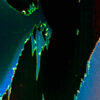Four electronic organs stand in a circle on the stage.
Four members of Piano Circus take seats at their organs and a fifth performer is standing in the middle to explain to us how to listen to the next piece, the second of the concert – Four Organs by Steve Reich (1970). The same performer introduced the first piece too. There, he was one of the pianists but here he is standing by an empty chair.
Both the concert programme and the music festival director have already warned us that this piece will be intense, both for the players, from whom great concentration is required, and for the audience. I had previously heard it described as a single chord for nineteen monotonous minutes, and so I expected exactly that – a chord held for that time, a kind of mirror in sound of John Cage’s 4’33, but much longer. I expected it to be quite hard work to sit through, leaving room for terrible thoughts, the kind that come to mind while lying awake in the dark.
Instead, like most of Reich’s early, minimalist work, the music is complex – and mysterious. Performers often feel it needs introducing, explaining. Conductor Michael Tilson Thomas once told his audience, ‘[it] really asks more of you than almost any other piece in the program. It’s a piece, really, for virtuoso listeners.’ He called understanding Four Organs ‘a bit like learning to look at one of Ad Reinhardt’s black-on-black paintings’. The experience of looking at a black canvas, like staring at a blank wall, mirrors your thoughts back to you – it doesn’t offer a narrative to follow, or new information, just an invitation to experience that moment of looking, listening.
The notes played are simple, but the rhythms are extremely complex. Reich wrote that the composition ‘began with a sentence on paper: “Short chord gets long!”’ The chord is deconstructed through the piece: each note is gradually separated in time from the others, so the chord is stretched out (a process known as augmentation). By the end it has slowed almost to a drone. Of the dominant eleventh chord he used for Four Organs, Reich said, ‘it contains the direction in which it wants to go and the arrival point simultaneously. It has the driving force of “I’ve gotta move!” in the bass, and the soprano voice doubled at the octave saying, “I’m already there!” . . . it’s a model of tension.’
After a few listens, the chord takes up residence in your brain. Even though I’ve heard a number of other Reich works live, none has stayed with me the way Four Organs has, especially the memory of watching the performers. Weeks later, having listened to and researched the piece ever since that March evening, and despite its lack of melody, I absent-mindedly find myself trying to whistle it.
The fifth player mentions that during one of its early performances, at Carnegie Hall in 1973, Four Organs provoked a riot.
This 18 January 1973 concert has become legendary – the story has been retold often and perhaps embellished. Now, Four Organs is rarely mentioned without bringing up the chaotic response at Carnegie Hall.
The piece was slipped into a context of otherwise familiar classical music. The audience, explained Tilson Thomas in a 2016 interview, expected ‘. . . elegant, gorgeously upholstered traditional music, and instead they got this piece for amplified rock organs’. People couldn’t bear to stay in their seats. Interviewed alongside the conductor, Steve Reich recalled, ‘We got about two, three minutes into it, and I think people in the audience were beginning to realise, this chord is not gonna change. And they didn’t like it!’ People coughed, booed, shook their fists. ‘We could scarcely hear ourselves playing and I had to in a very loud voice count out the numbers of the beats,’ said Tilson Thomas. Both used the same term for what happened afterwards: the conductor said, ‘at the end of the piece, there was a moment of silence and then there was just an avalanche of noise’; Reich echoed, ‘there was this avalanche of BOO, BRAVO, BOO . . .’
I’m struck by the contrast between that story and this quiet, fascinated and respectful audience. We stay silent as expected, a middle-class Cambridge crowd, until we applaud for the expected time, volume and length.
‘Relax and let the patterns do their work,’ the fifth performer tells us. Then he picks up a pair of maracas.
Surrounded by his colleagues piecing out the complex, nuanced elongations of the single chord, this player is doing exactly the same thing from beginning to end. The score reads: ‘maracas continue unbroken eight notes throughout’. He is the still form in the centre of the ensemble, but also the rhythm around which the rest of the piece revolves. He sets the speed, and helps the others precisely align their playing with each other and to count the beats. His rhythm provides a background structure that is almost like white noise at times, and then comes to the fore as my attention circulates between the different players and sounds. In his continuous, small repetitive movements he is an unchanging anchor.
Four Organs was Reich’s return to live instrumentation after his electronic experiments with the ‘phase shifting pulse gate’, a machine he invented for his compositional works structured around a repeated pattern played at gradually diverging speeds by players and/or looped tapes, known as phasing. He later wrote that ‘the “perfection” of rhythmic execution of the gate . . . was stiff and unmusical. In any music that depends on a steady pulse, as my music does, it is actually tiny microvariations of that pulse created by human beings, playing instruments or singing, that gives life to the music.’ The maracas player has become the human machine, providing the pulse that sets the pace for the development of the chord.
The maracas player starts off with his eyes closed.
The stage lights flicker on the concrete wall behind the players as their small, rhythmic hand movements create reflections, like the rippling water of a canal reflected on the ceiling of a houseboat at night. I watch each player in turn and then I watch the signals between them, but again and again my attention is drawn back to the central figure, the maracas player, even though the drama – the concentrated counting, the tension between the four organists, the exactitude of their synchronised movements – is elsewhere. By the end I can’t take my eyes off him. In his moving stillness he exudes something extreme and meditative.
It makes me think of when I was younger and worked some evenings as a life model.
Posing was both intense and peaceful. I felt a simultaneous awareness of the cold in the large, ill-insulated space and the warmth of the small electric heater. I loved the liberation of taking off my dressing gown in a room of clothed people. The absolute freedom – dare I say minimalism – of being nude, possessionless, anonymous; just a body, lit, arranged and drawn. The liberating clarity of a single, simple task. There is just one thing being asked of you, to be still. You’re unreachable, and no one speaks to you once the pose has started. Everyone is concentrating deeply, looking at you, yes, but looking as artists at a shape in an impersonal way, so you’re also removed from yourself, from judgement.
I would not move for five, ten or twenty minutes for quick sketches, or up to forty minutes for a detailed drawing. During the short stints, I mostly thought about what my next pose would be, wanting to give the artists variety, but also to move my muscles in the opposite direction, bending a different limb, untwisting my spine.
Long poses were harder and often uncomfortable. The best way, I found, to get through it was never to think about the time. To settle into the stillness as though it would last forever; to stop wishing for it to end or thinking about the next thing, except to vaguely plan what to have for dinner. There was never a clock in the studio. I tried to focus on nothing and let my thoughts wander. I could do that then – I was still young, confident and healthy. I learned that while keeping still I could make small, invisible adjustments to stretch muscles, relax or tense them, to stay comfortable within the unchanging arrangement of limbs – Reich’s microvariations of the human body. Once I had fully accepted that the pose would not end, it was a delightful surprise when time was called.
Sometimes I would realise a position was really impossible to hold for the length of time given, whether long or short, especially if I’d stupidly raised an arm – wanting to provide a dynamic subject for drawing, but forgetting it would soon go numb, then dead, then spookily cold. I’d know I’d have to break pose, disrupt the drawings, start a riot, but I’d hang on as long as I could and then a bit longer, into the discomfort, too long, sometimes hurting myself, keeping to the absolute stillness I felt was required, that I’d committed to, was being paid for.
This was all excellent training for what followed. I could always hold my poses until what turned out to be the last session, when I suddenly felt old, and felt the cold in my bones all night afterwards. A few weeks later I was diagnosed with leukaemia. Cancer treatment is an endurance too.


Sign in to Granta.com.








